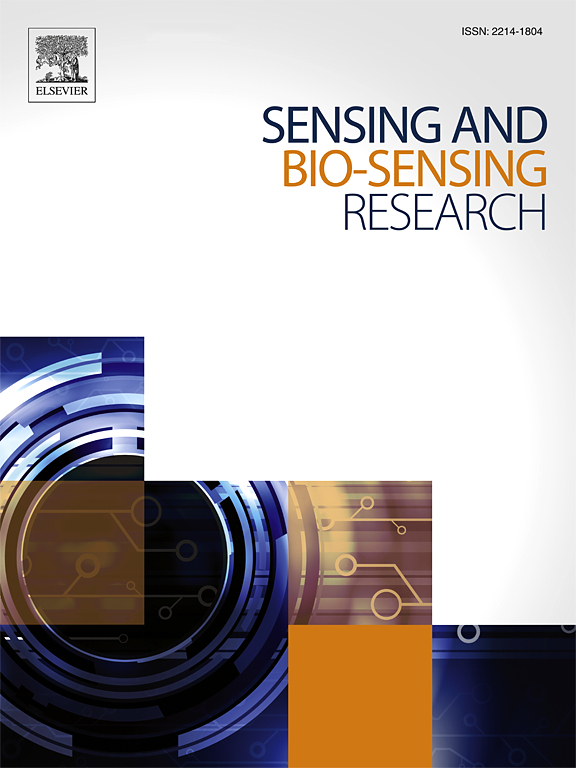Advanced THz Optical Sensor for Ethanol and Benzene Detection: A Step towards Safer Industrial and Environmental Monitoring
IF 4.9
Q1 CHEMISTRY, ANALYTICAL
引用次数: 0
Abstract
Ethanol and Benzene are harmful to climate change, the human body, biodiversity, and long-term ecosystem balance. Normally, ethanol is added to gasoline, which causes climate change, and benzene is used in industries, which can cause cancer. Therefore, it is crucial to accurately identify both ethanol and benzene to ensure people's safety in the environment. This study shows a new and powerful photonic crystal fiber (PCF) sensor that uses terahertz (THz) technology. This sensor is designed to detect ethanol and benzene with high accuracy. The sensor works better because it has a special shape with a six-sided (hexahedron) center and a hexagonal outer cladding layer. According to our experiments, at 2.2 THz, the PCF sensor achieves relative sensitivities of 96.35 % for ethanol and 97.05 % for benzene. Effective Material Loss (EML), Effective Area, and Confinement Loss (CL) for ethanol and benzene are 0.0032 cm−1 and 0.0024 cm−1, 6.88 × 10−8 m2 and 7.79 × 10−8 m2 respectively, and 1.84 × 10−7 dB/m and 1.89 × 10−7 dB/m respectively, with operating frequency at 2.2 THz. There are various traditional detection techniques to detect those chemicals, but this proposed optical sensor performs better. So, the proposed PCF sensor demonstrates high sensitivity in simulation and indicates promising potential for future application in industrial safety and environmental monitoring.
用于乙醇和苯检测的先进太赫兹光学传感器:迈向更安全的工业和环境监测的一步
乙醇和苯对气候变化、人体、生物多样性和长期生态系统平衡都是有害的。通常情况下,乙醇被添加到汽油中,这会导致气候变化,苯被用于工业,会导致癌症。因此,准确识别乙醇和苯对于确保人们在环境中的安全至关重要。本研究展示了一种使用太赫兹(THz)技术的新型、强大的光子晶体光纤(PCF)传感器。该传感器用于乙醇和苯的高精度检测。这种传感器效果更好,因为它有一个特殊的形状,有一个六面(六面体)中心和一个六边形的外层包层。实验结果表明,在2.2 THz下,PCF传感器对乙醇的相对灵敏度为96.35%,对苯的相对灵敏度为97.05%。当工作频率为2.2 THz时,乙醇和苯的有效物质损耗(EML)、有效面积(Effective Area)和约束损耗(CL)分别为0.0032 cm−1和0.0024 cm−1,6.88 × 10−8 m2和7.79 × 10−8 m2, 1.84 × 10−7 dB/m和1.89 × 10−7 dB/m。有各种传统的检测技术来检测这些化学物质,但这种提出的光学传感器性能更好。因此,所设计的PCF传感器在仿真中具有较高的灵敏度,在工业安全和环境监测中具有广阔的应用前景。
本文章由计算机程序翻译,如有差异,请以英文原文为准。
求助全文
约1分钟内获得全文
求助全文
来源期刊

Sensing and Bio-Sensing Research
Engineering-Electrical and Electronic Engineering
CiteScore
10.70
自引率
3.80%
发文量
68
审稿时长
87 days
期刊介绍:
Sensing and Bio-Sensing Research is an open access journal dedicated to the research, design, development, and application of bio-sensing and sensing technologies. The editors will accept research papers, reviews, field trials, and validation studies that are of significant relevance. These submissions should describe new concepts, enhance understanding of the field, or offer insights into the practical application, manufacturing, and commercialization of bio-sensing and sensing technologies.
The journal covers a wide range of topics, including sensing principles and mechanisms, new materials development for transducers and recognition components, fabrication technology, and various types of sensors such as optical, electrochemical, mass-sensitive, gas, biosensors, and more. It also includes environmental, process control, and biomedical applications, signal processing, chemometrics, optoelectronic, mechanical, thermal, and magnetic sensors, as well as interface electronics. Additionally, it covers sensor systems and applications, µTAS (Micro Total Analysis Systems), development of solid-state devices for transducing physical signals, and analytical devices incorporating biological materials.
 求助内容:
求助内容: 应助结果提醒方式:
应助结果提醒方式:


